Crafts
This is an introduction to various crafts symbolic of Japanese culture, ranging from Uchiwa (traditional Japanese fans) and Tenugui (flat-woven cotton cloths) to other techniques recognized as traditional Mie brands.

This culture and its traditions were referred to as "Shinto" and one of its most representative architectural structures is the Shinto shrine, used as a place to worship the gods.
The work on display here is the "Kamidana" or household altar. The household altar or home shrine came about from people wanting to show the same deep respect when welcoming gods (as mentioned earlier) into the home as at a Shinto shrine. The Japanese people have a long tradition of erecting such altars in their homes.
Since our company's establishment to the present day, we have poured our heart and soul into carefully creating each work, adhering to time-honored techniques passed down by "Miyashi" (craftsmen who make household altars) in the holy region of Ise. True to the Japanese spirit of "Wa" (harmony), we pay meticulous attention to the materials used to create each household altar.
The thatched roof household altar is designed on the model of Ise Shrine, where the sun goddess Amaterasu Omikami, the supreme deity in the Shinto pantheon and the mythological ancestor of the Imperial Family, is enshrined. Ise Shrine is built using Japan's oldest architectural style, called "Yuiitsu shinmei-zukuri."
The roof has been thatched and the main structure uses wooden materials which are inextricably linked with Japanese culture. We have selected high quality Kiso hinoki (Japanese cypress) for this purpose.
I hope that the Japanese spirit of "Wa" (harmony) and culture is conveyed through this work.
"Sumi" is ground with water on an ink slab and then used in its black liquid form.
It is said that the production of Suzuka ink can be traced back to the 8th century. Suzuka ink supposedly originated when Sumi was made after burning pine resin and then gathering the soot. During the Edo Period (166~1867), Sumi production expanded rapidly.
Even today, Suzuka ink is made using difficult manual procedures and it is favored by many calligraphers for its delicate fragrance and brilliant black color.

Katagami Stencil Lamps - Yunagi (Evening Calm)
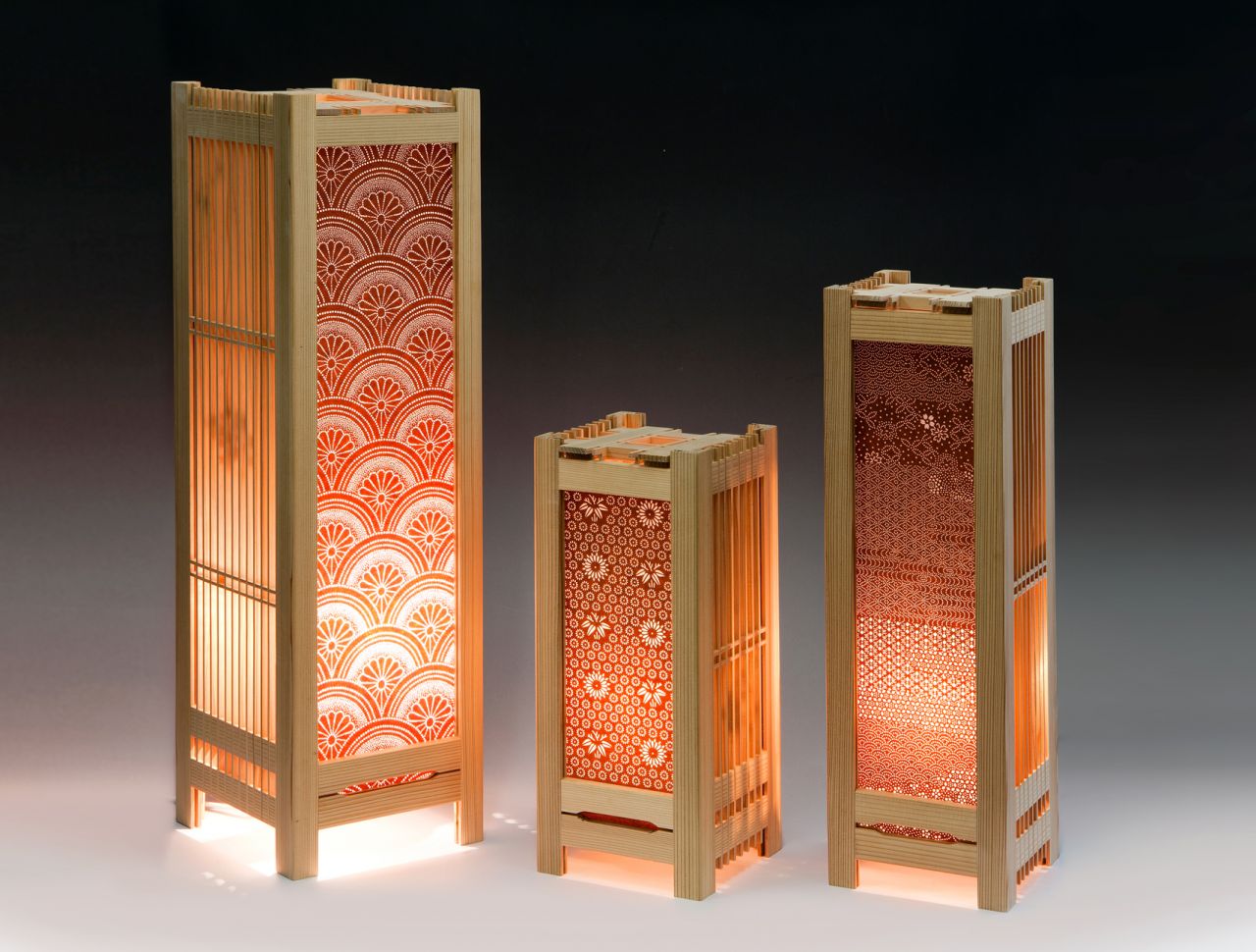
Ise Katagami stencils were originally used for dyeing patterns into the fabric of kimono. It is a traditional craft with a long history of over 1000 years. The craft developed significantly during the Edo period under the protection of the Kishū Domain. It was at its peak during the post-war period, but with the decline in demand for kimono thereafter, production was subsequently downsized. In recent years, the works have been recognized for their design value and they are now exhibited in art galleries. The Katagami stencils were taken abroad during the Meiji and Taisho periods where they had a profound influence on Western fine and applied arts within the context of Japonism. This information only came to light in a recent study. Consequently, Katagami stencils are now used not only for dyeing, but also for artistic and interior design applications. The appeal of Katagami surpasses all generations and it is now being passed down to the current generation.
Against this backdrop, we endeavored to create Katagami lighting products, and developed "Yūnagi," an LED Katagami lamp. The origin of the word "Yūnagi" comes from the moment when the sea breeze changes to become a land breeze at dusk and one experiences a moment of dead calm. Please enjoy a quiet and tranquil moment while gazing upon the Katagami pattern of your Yūnagi Katagami Lamp.
Ise Katagami Cooperative

The origin of Iga braids is old, and it is said that it dates back to the time before the Nara Period.
In the Heian Period, artistic cords such as the flat braided strap of the Karakumi, sutra scrolls, keko (flower basket), and hatakazari (flag decorations) came into use in Buddhist altars and Shinto home shrines, etc..
When the period of the Samurai class began, many cords for armor and swords were produced, and the braided cord culture centered around weaponry was born. When the decree banning the wearing of swords came out and the Samurai class collapsed,
the traditional braiding techniques of the Edo period were passed down to the obishime (decorative string used to hold a kimono sash in place) essential for the kimono, and haori-himo (a string tied across the open chest of a haori coat).
Also, production with braiding machines that make use of traditional techniques, and research progressed as well, and the land of Iga increasingly developed as an area specializing in braided cords. Nowadays, the techniques have been firmly passed down for straps and accessories, etc. that are also in demand in recent years.
Beautifully died silks, with their intermingling lines and unique textures, began to brew a new flavor. The techniques continue unbroken from ancient times. The hearts of many people are joined to form a single braid over a long stretch of time. That is the beauty that weaves the flavor of braids.
Mie Prefecture Braid Cooperative

1951
born in Nagoya
1975
graduated from the Design Department of the Aichi Prefectural University of Fine Arts and Music
1990-1997
[group exhibitions]Exhibition of Akira Isoda and ten writers (Aichi Prefecture Museum of Art); Contemporary Prints IN NAGOYA (Aichi Prefecture Museum of Art); many others
1975-2011
[one-man exhibitions]Matsuya Ginza Tokyo, Matsuzakaya head office, Mikimoto, and 35 others
It has the characteristics of a good texture and being less likely to wrinkle, because it is slowly woven on an old-fashioned loom using a weakly-twisted single thread. The more you use it the more its flavor comes out. It is mainly used in tailoring kimonos.
Usui Shokufu Co., Ltd.

A characteristic feature of the Hinaga uchiwa is that the whole fan is made from a single piece of thin, round bamboo wood. The fans are round in shape, easy to grasp and feel cool to the touch. The fans are made of the finest Medake bamboo which is also used to make fishing rods. The bamboo is carefully carved into fine pieces so as to keep the handle round and give elasticity and suppleness to the bowlike delicate strings. Since the three-dimensional bamboo has to be stretched flat into a fan shape, the process involved is difficult and requires great technical skill. Fanning oneself with a Hinaga uchiwa creates a gentle airflow that makes one feel luxuriously soothed.
In addition, because the bamboo used is round in shape, this creates an empty space just above the handle into which a small fragrant paper ball is placed. When fragrant oil is dropped onto the ball, the Hinaga uchiwa becomes a fragrant fan. This is a new, innovative style of Hinaga uchiwa that has been developed more recently in the company's 300-year-long history.
Inatoh Inc.

For this reason, the fabrics are both breathable and regulate humidity. The cotton fabrics created are also resistant to wrinkles and are gentle on the skin. As you wash the thread, the natural starch comes off and the texture of the fabric softens. Please enjoy supreme Tenugui (hand towels) which combine the traditional techniques of expert craftsmen with functional beauty.
Tokowakaya

Kumiko Coasters
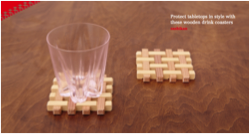
The traditional Japanese craft of Kumiko or refined lattice-work is the technique used to create these coasters.
Kumiko involves the technique of taking one piece of wood and then cutting it into multiple detailed segments. Incisions are made in the individual segments and these are then interlocked to create intricate designs.
It is said that this technique originated in the Muromachi period and developed together with "Shoin-zukuri," a traditional style of Japanese residential architecture.
The Kumiko coasters, in which the wood appears to have been interwoven, utilizes the neji-gumi or twisted lap joint traditional method that is one of the Kumiko or lattice-work techniques.
These are mysterious-looking coasters in which the wooden segments look like they will fall out, despite being firmly locked in place. They are constructed completely by hand. The coasters have a natural sweet wooden aroma since they have not been coated.
Sashikan Tategu Kogei

Ise Shinden (Shrine)
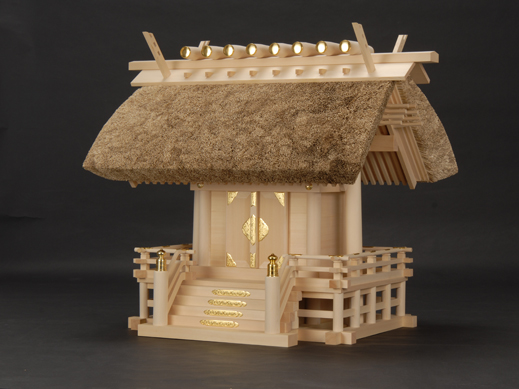
It is said that the Japanese, similar to other nations, had a culture of respecting and worshipping nature as gods, in the form of mountains, oceans, rivers and wind, as well as honoring and deifying ancestors and people who were known for their great achievements. 
This culture and its traditions were referred to as "Shinto" and one of its most representative architectural structures is the Shinto shrine, used as a place to worship the gods.
The work on display here is the "Kamidana" or household altar. The household altar or home shrine came about from people wanting to show the same deep respect when welcoming gods (as mentioned earlier) into the home as at a Shinto shrine. The Japanese people have a long tradition of erecting such altars in their homes.
Since our company's establishment to the present day, we have poured our heart and soul into carefully creating each work, adhering to time-honored techniques passed down by "Miyashi" (craftsmen who make household altars) in the holy region of Ise. True to the Japanese spirit of "Wa" (harmony), we pay meticulous attention to the materials used to create each household altar.
The thatched roof household altar is designed on the model of Ise Shrine, where the sun goddess Amaterasu Omikami, the supreme deity in the Shinto pantheon and the mythological ancestor of the Imperial Family, is enshrined. Ise Shrine is built using Japan's oldest architectural style, called "Yuiitsu shinmei-zukuri."
The roof has been thatched and the main structure uses wooden materials which are inextricably linked with Japanese culture. We have selected high quality Kiso hinoki (Japanese cypress) for this purpose.
I hope that the Japanese spirit of "Wa" (harmony) and culture is conveyed through this work.
Ise Miyachu

Suzuka Ink
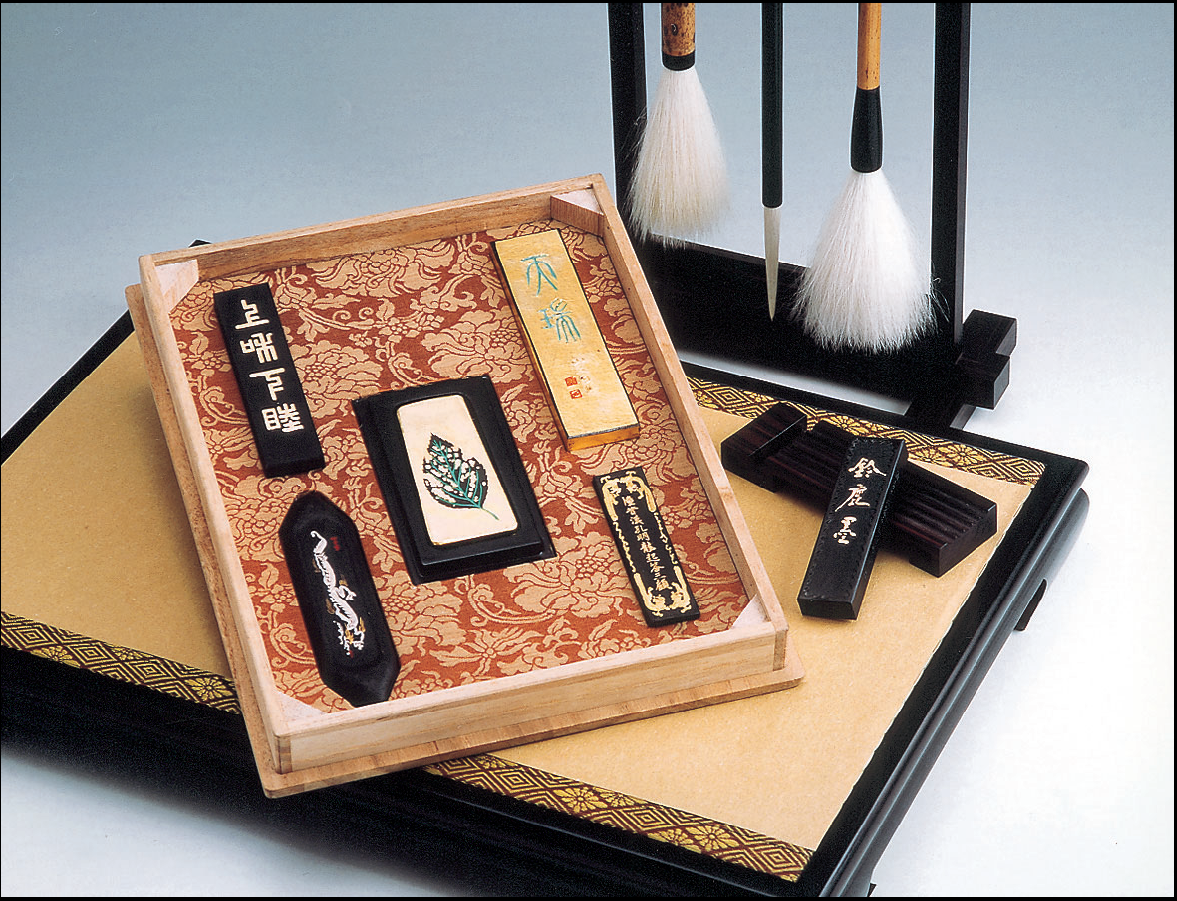
"Sumi,” a type of black Japanese ink prepared in solid sticks, has been used by the Japanese since ancient times for writing and painting.
"Sumi" is ground with water on an ink slab and then used in its black liquid form.
It is said that the production of Suzuka ink can be traced back to the 8th century. Suzuka ink supposedly originated when Sumi was made after burning pine resin and then gathering the soot. During the Edo Period (166~1867), Sumi production expanded rapidly.
Even today, Suzuka ink is made using difficult manual procedures and it is favored by many calligraphers for its delicate fragrance and brilliant black color.
Sinseido co.,ltd.
Katagami Stencil Lamps - Yunagi (Evening Calm)

Ise Katagami stencils were originally used for dyeing patterns into the fabric of kimono. It is a traditional craft with a long history of over 1000 years. The craft developed significantly during the Edo period under the protection of the Kishū Domain. It was at its peak during the post-war period, but with the decline in demand for kimono thereafter, production was subsequently downsized. In recent years, the works have been recognized for their design value and they are now exhibited in art galleries. The Katagami stencils were taken abroad during the Meiji and Taisho periods where they had a profound influence on Western fine and applied arts within the context of Japonism. This information only came to light in a recent study. Consequently, Katagami stencils are now used not only for dyeing, but also for artistic and interior design applications. The appeal of Katagami surpasses all generations and it is now being passed down to the current generation.
Against this backdrop, we endeavored to create Katagami lighting products, and developed "Yūnagi," an LED Katagami lamp. The origin of the word "Yūnagi" comes from the moment when the sea breeze changes to become a land breeze at dusk and one experiences a moment of dead calm. Please enjoy a quiet and tranquil moment while gazing upon the Katagami pattern of your Yūnagi Katagami Lamp.
Ise Katagami Cooperative
Iga braids
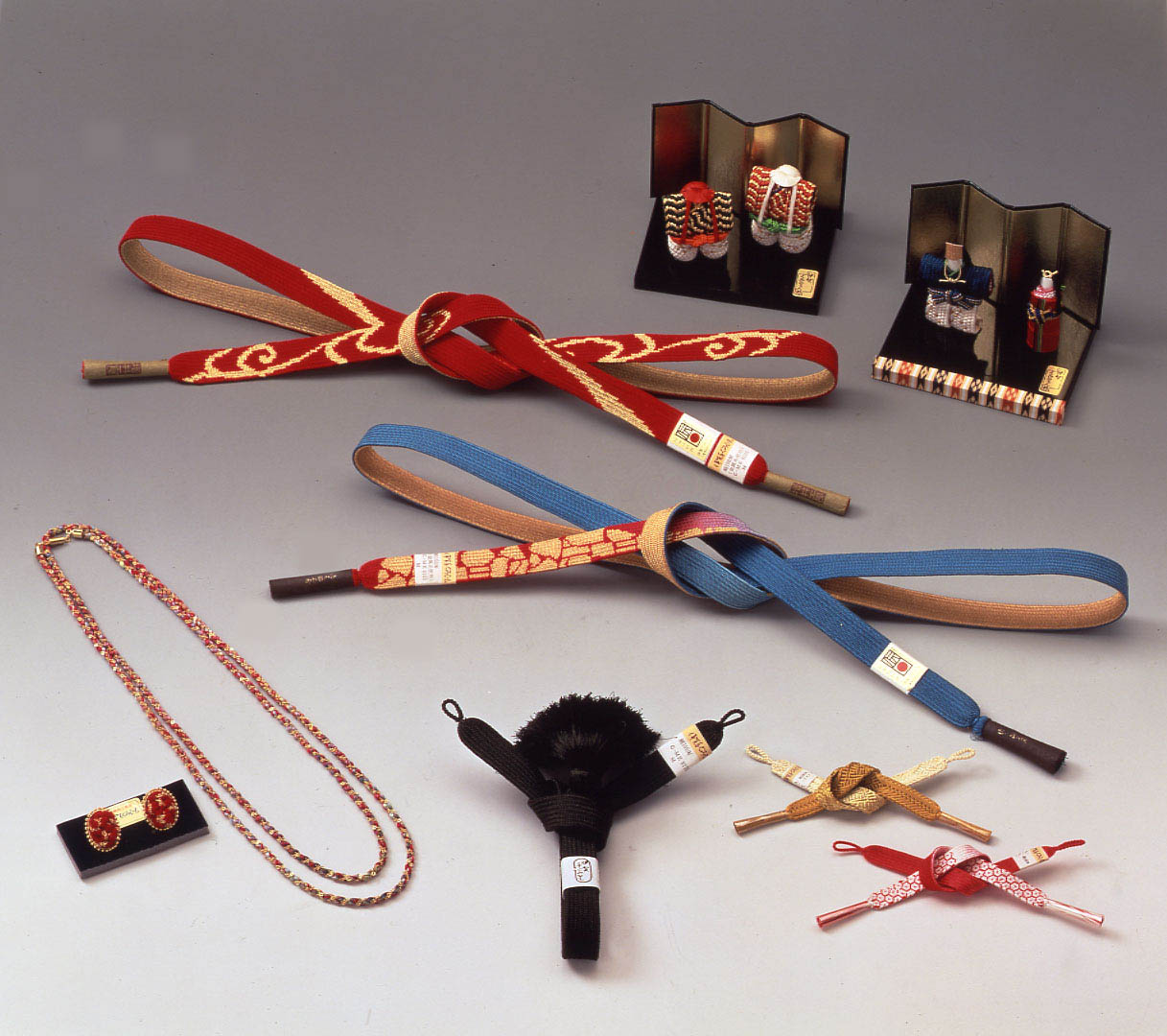

The origin of Iga braids is old, and it is said that it dates back to the time before the Nara Period.
In the Heian Period, artistic cords such as the flat braided strap of the Karakumi, sutra scrolls, keko (flower basket), and hatakazari (flag decorations) came into use in Buddhist altars and Shinto home shrines, etc..
When the period of the Samurai class began, many cords for armor and swords were produced, and the braided cord culture centered around weaponry was born. When the decree banning the wearing of swords came out and the Samurai class collapsed,
the traditional braiding techniques of the Edo period were passed down to the obishime (decorative string used to hold a kimono sash in place) essential for the kimono, and haori-himo (a string tied across the open chest of a haori coat).
Also, production with braiding machines that make use of traditional techniques, and research progressed as well, and the land of Iga increasingly developed as an area specializing in braided cords. Nowadays, the techniques have been firmly passed down for straps and accessories, etc. that are also in demand in recent years.
Beautifully died silks, with their intermingling lines and unique textures, began to brew a new flavor. The techniques continue unbroken from ancient times. The hearts of many people are joined to form a single braid over a long stretch of time. That is the beauty that weaves the flavor of braids.
Mie Prefecture Braid Cooperative
Kenji Yoshida, who continues to draw shell diving women, copper plate engravings
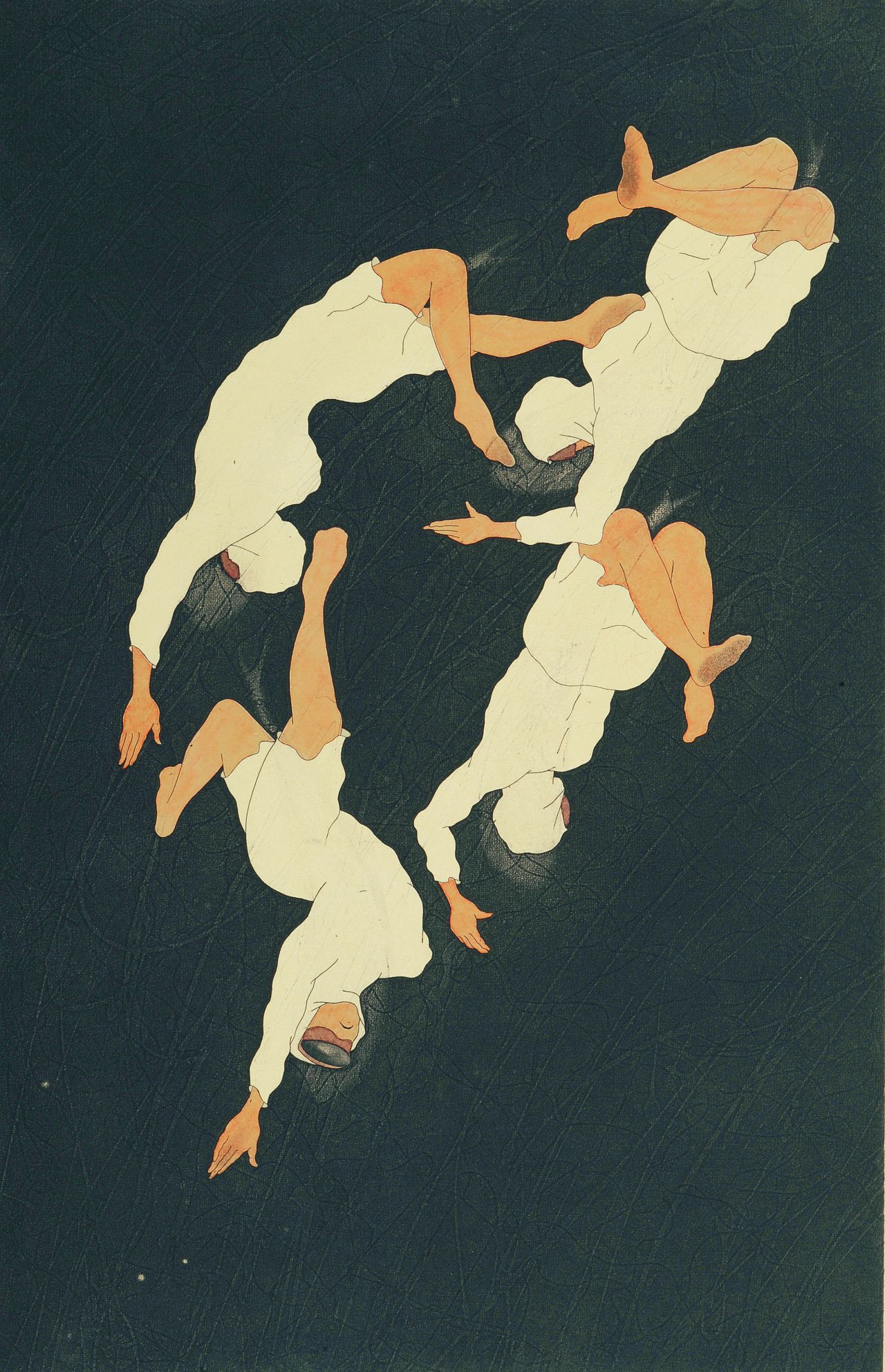
Profiled artist / Kenji Yoshida
1951
born in Nagoya
1975
graduated from the Design Department of the Aichi Prefectural University of Fine Arts and Music
1990-1997
[overseas exhibitions]Turkey, Spain, South Korea, Thailand, etc.
1977-2009[group exhibitions]Exhibition of Akira Isoda and ten writers (Aichi Prefecture Museum of Art); Contemporary Prints IN NAGOYA (Aichi Prefecture Museum of Art); many others
1975-2011
[one-man exhibitions]Matsuya Ginza Tokyo, Matsuzakaya head office, Mikimoto, and 35 others
Toba Chamber of Commerce and Industry

Ise-Momen
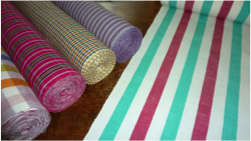
In Ise, the cotton industry has thrived since the Edo Period. The cotton produced was sold nation-wide by Ise merchants and became popularly known as, "Ise Cotton." In the Meiji period, the power loom was invented, and our company also introduced the Toyota power loom in an effort to increase production. After the war, along with the development of synthetic fibers and the westernization of lifestyles, manufacturers went out of business one after the other, so now "Usui Shokufu (Inc.)" is the only company producing "Ise Cotton."
It has the characteristics of a good texture and being less likely to wrinkle, because it is slowly woven on an old-fashioned loom using a weakly-twisted single thread. The more you use it the more its flavor comes out. It is mainly used in tailoring kimonos.
Usui Shokufu Co., Ltd.
Fragrance-Uchiwa (Fans)
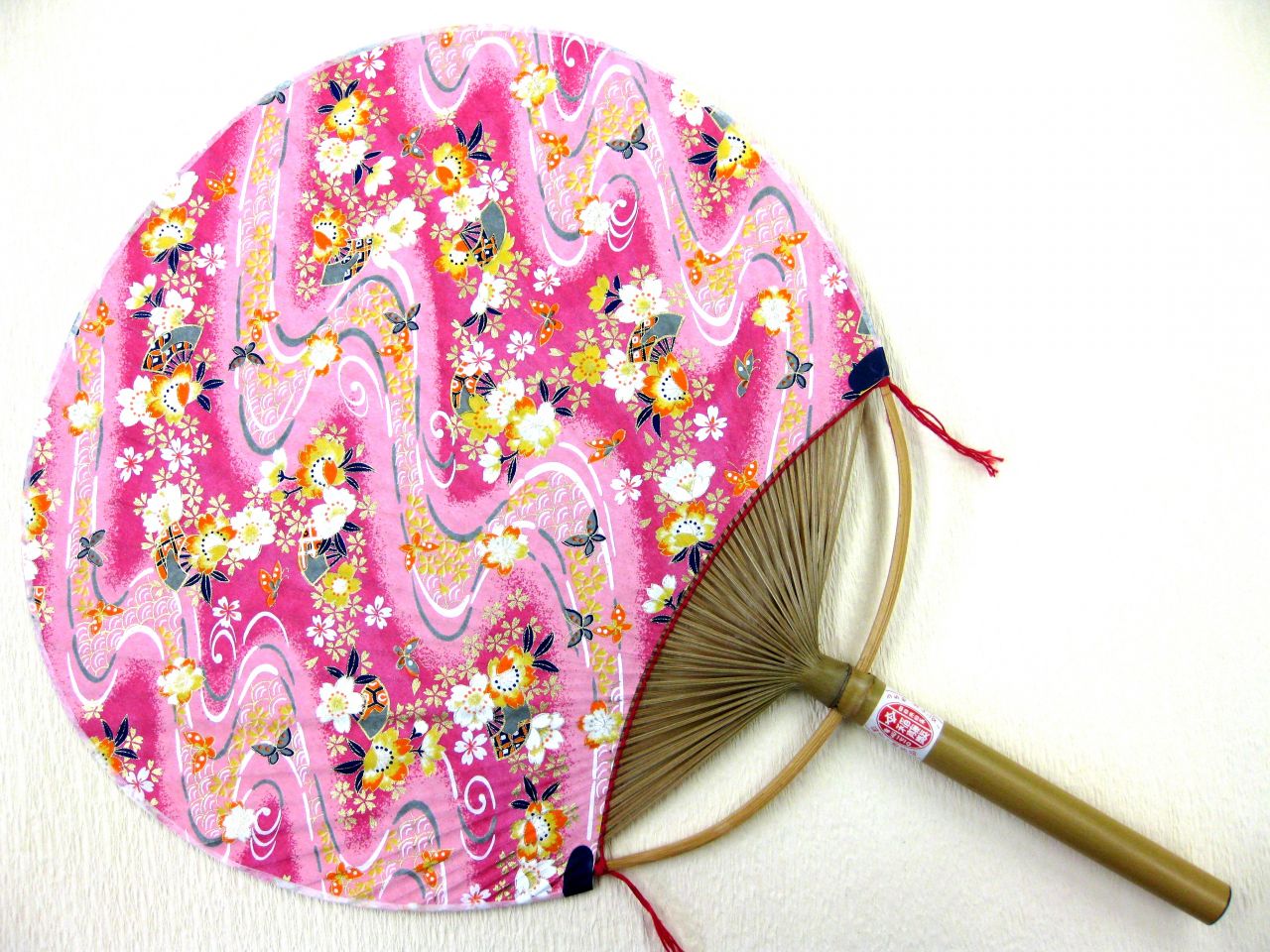
Since the Edo period, farmers in Ise prefecture's Hinaga district have had flourishing side-businesses of making uchiwa or round paper fans during the agricultural off-season. Many visitors to the region buy the famous local uchiwa fans to take home as presents or souvenirs.
A characteristic feature of the Hinaga uchiwa is that the whole fan is made from a single piece of thin, round bamboo wood. The fans are round in shape, easy to grasp and feel cool to the touch. The fans are made of the finest Medake bamboo which is also used to make fishing rods. The bamboo is carefully carved into fine pieces so as to keep the handle round and give elasticity and suppleness to the bowlike delicate strings. Since the three-dimensional bamboo has to be stretched flat into a fan shape, the process involved is difficult and requires great technical skill. Fanning oneself with a Hinaga uchiwa creates a gentle airflow that makes one feel luxuriously soothed.
In addition, because the bamboo used is round in shape, this creates an empty space just above the handle into which a small fragrant paper ball is placed. When fragrant oil is dropped onto the ball, the Hinaga uchiwa becomes a fragrant fan. This is a new, innovative style of Hinaga uchiwa that has been developed more recently in the company's 300-year-long history.
Inatoh Inc.
Okage Tenugui (Hand Towels)
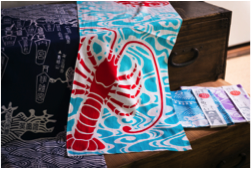
Ise "Momen" Cotton uses only the finest, high-grade, extra-long cotton and has continued to produce traditional cloth for over 250 years since the Edo period. The highest quality thread is lightly twisted into individual threads, hardened in starch and then carefully woven.
For this reason, the fabrics are both breathable and regulate humidity. The cotton fabrics created are also resistant to wrinkles and are gentle on the skin. As you wash the thread, the natural starch comes off and the texture of the fabric softens. Please enjoy supreme Tenugui (hand towels) which combine the traditional techniques of expert craftsmen with functional beauty.
Tokowakaya
Kumiko Coasters

The traditional Japanese craft of Kumiko or refined lattice-work is the technique used to create these coasters.
Kumiko involves the technique of taking one piece of wood and then cutting it into multiple detailed segments. Incisions are made in the individual segments and these are then interlocked to create intricate designs.
It is said that this technique originated in the Muromachi period and developed together with "Shoin-zukuri," a traditional style of Japanese residential architecture.
The Kumiko coasters, in which the wood appears to have been interwoven, utilizes the neji-gumi or twisted lap joint traditional method that is one of the Kumiko or lattice-work techniques.
These are mysterious-looking coasters in which the wooden segments look like they will fall out, despite being firmly locked in place. They are constructed completely by hand. The coasters have a natural sweet wooden aroma since they have not been coated.
Sashikan Tategu Kogei
To the TOP
